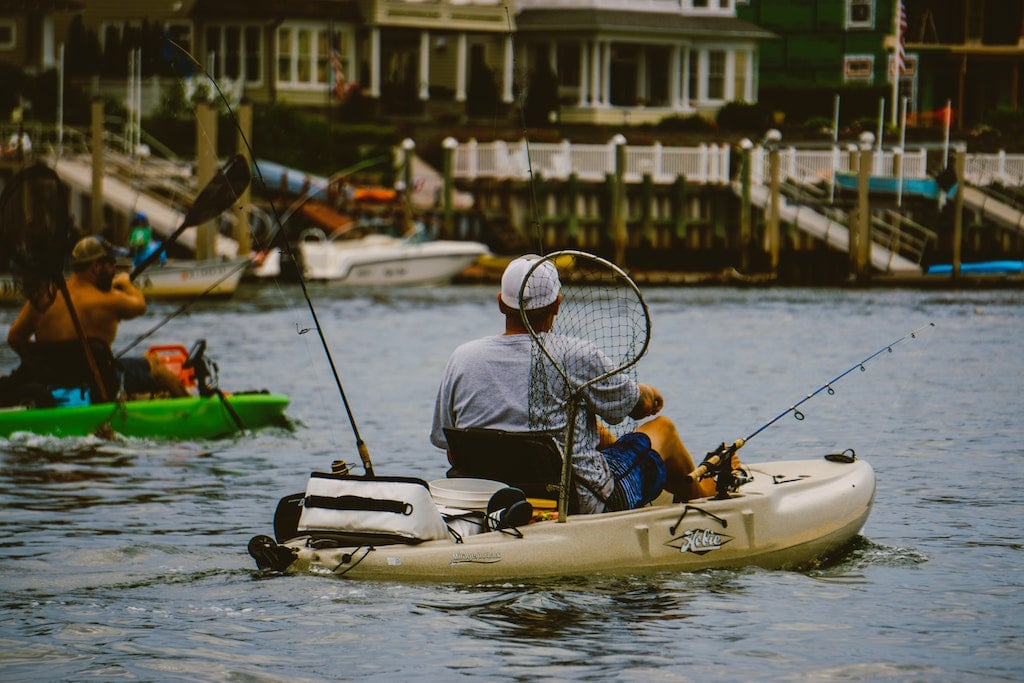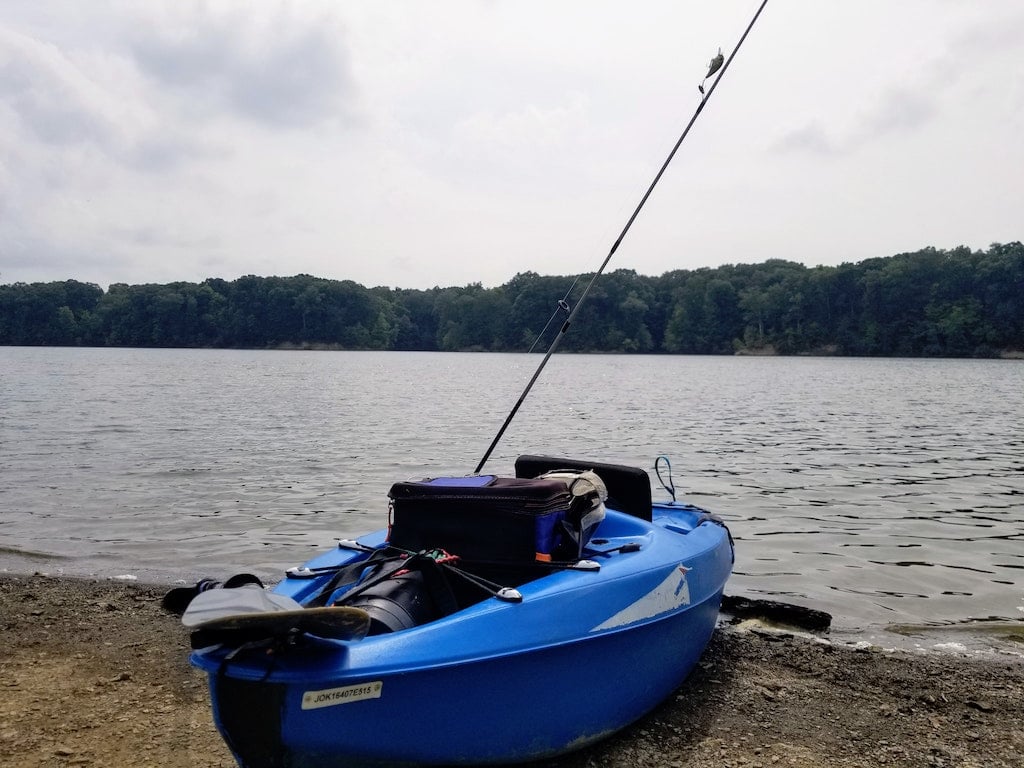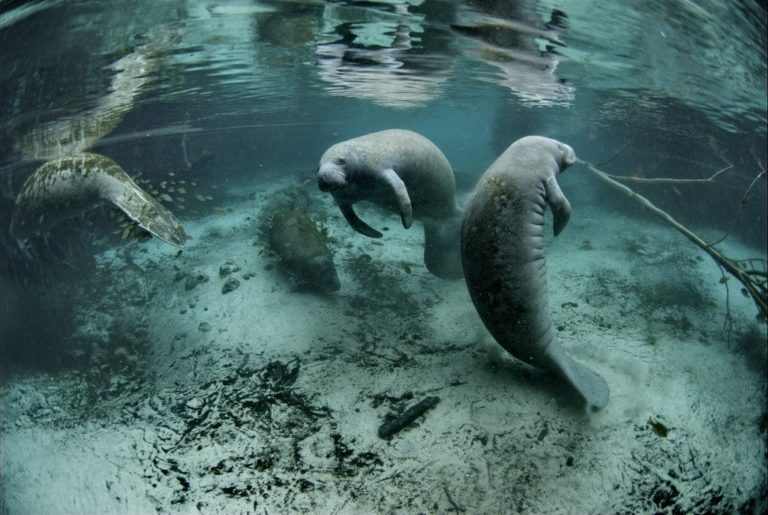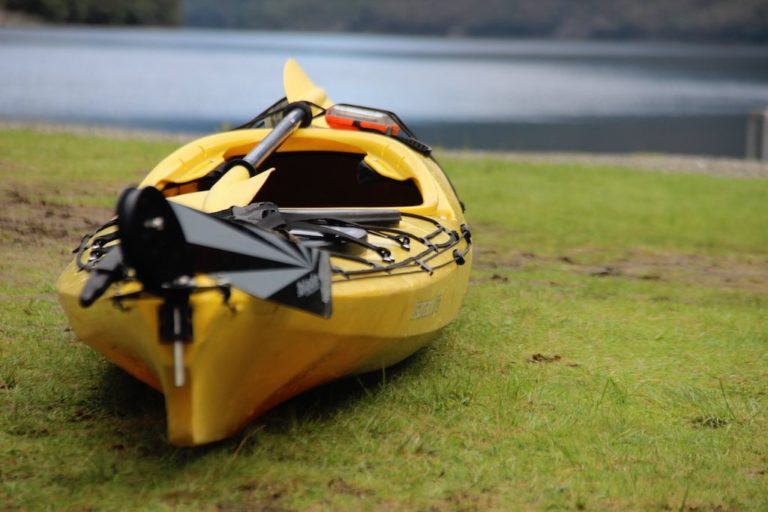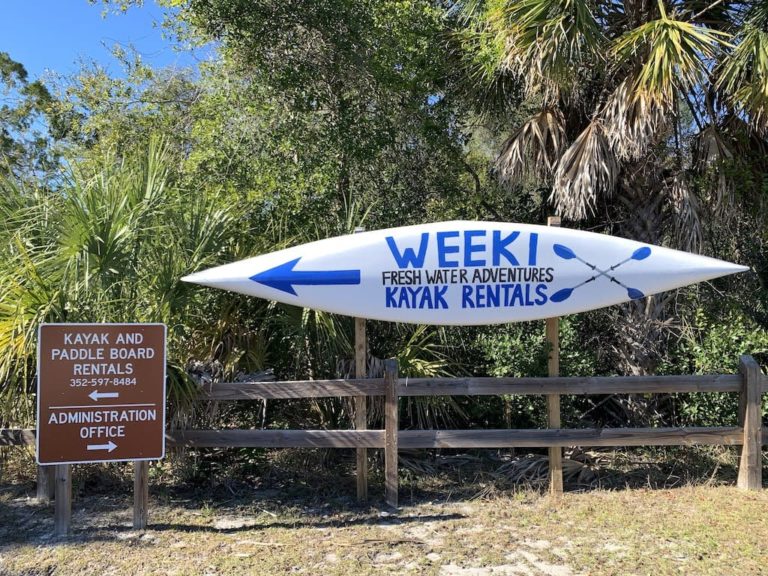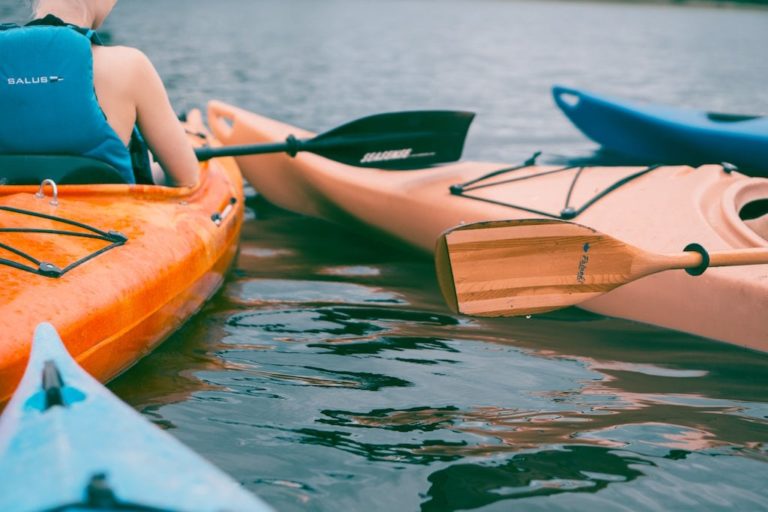Guide to Fishing Kayaks
Fishing kayaks can be great tools to expand your fishing territory!
Fishing kayaks do have some downsides compared to traditional fishing boats. But, fishing kayaks are useful and versatile; they’re often underestimated in the fishing community. If you’re interested in options to get on the water and fish away from shore, a fishing kayak may be a good option.
Advantages and Benefits of Fishing Kayaks
Fishing kayaks have many advantages. Many anglers who try kayak fishing are instantly hooked. Some strongly prefer kayak fishing to other boats and watercraft.
One of the best qualities of fishing kayaks is that they can be incredibly simple. They remove many of the hassles, costs, complexities and barriers that come with owning or using a traditional fishing boat.
Fishing kayaks can be very inexpensive to buy, simple to rig, and inexpensive to maintain. For all of these reasons, fishing kayaks can offer a very low-cost entry into fishing.
Other advantages of fishing kayaks:
- Silence and lack of noise make it easy to sneak up on fish
- Shallow draft allows excellent access to shallow and obstructed waterways
- Decreased reliance on boat ramps, more options for launching
- Better connection to nature
- Lower cost of ownership
- No engine cost or maintenance*
- No trailer maintenance*
- Many states do not require legal registration
- More time spent fishing, less time spent on hassles!
*Some people choose to have trailer kayaks, and some kayaks feature motors.
Disadvantages of Fishing Kayaks
Every watercraft has tradeoffs; fishing kayaks have several downsides compared to other types of boats. Here are some disadvantages of fishing kayaks to keep in mind.
Fishing kayaks are small by design, which is both a blessing and a curse relative to other boats. On one hand, the reduced size of kayaks allows amazing maneuverability, access to tight spaces and ease of handling.
On the downside, you may not be able to bring passengers, you can carry less gear, and some people prefer to have room to stand and walk around. Some people feel claustrophobic in fishing kayaks.
Other types of fishing boats can also carry a much higher payload, and much bulkier gear. That said, fishing kayaks can comfortably hold more weight and gear than one could reasonably carry while walking on foot, or even transport in a fishing wagon.
Fishing kayaks can provide easy access to new fishing grounds compared to shore-based fishing. And, they can tuck up into tight and shallow areas where big boats can’t fit, or float.
But, they have some downsides when it comes to long-range navigation, or wide-open bodies of water without adequate protection from wind and waves.
Fishing kayaks may be a poor choice for fishing during high winds because strong winds may be difficult to paddle against. High winds may create large waves or choppy conditions which would also make kayak fishing difficult, dangerous or uncomfortable.
Non-kayak fishing boats, especially those with motors, can cover long distances at high speeds. Motorboats can open up new fishing grounds which might be unsafe, impractical or impossible to access via fishing kayak.
Because they are wider, fishing kayaks tend to be less efficient and slower than other types of kayaks, especially long, narrow and sleek touring kayaks.
One of the biggest disadvantages to fishing kayaks, compared to traditional fishing boats, is the challenge of trolling.
In other types of boats trolling is easy because a motor moves the boat while your hands are free to fish. In a kayak your hands are occupied with paddling, and depending on your paddle stroke, you may also be splashing a lot, which is not ideal for fishing.
There are ways around this challenge, though. Some fishing kayaks have pedals which allow smooth, quiet and hands-free propulsion so your hands are free to fish. There are also some kayaks with electric trolling motors.
Another option is to drift in the wind or water current. Some fishing kayakers use a type of water anchor, often called a “drift sock”, when running currents. Drift socks allow your kayak to be pulled or pushed along passively by the wind or current while your hands are free for you to fish. The drift sock will keep your movement slow, steady and controlled, which is ideal for trolling.
Advanced fishermen with excellent balance may even be able to stand up in the kayak and fish while being pulled along in the current, unlike pedal-driven kayaks which would require you to be sitting to use the foot pedals.
What Kinds of Fish Can You Catch From Kayaks?
Kayak fishermen go after almost all types of fish! Some even target large, hard-fighting game species like cobia, grouper, tarpon, kingfish.
And, because people always ask: yes, some brave anglers even go shark fishing from kayaks.
Many fishermen think that the best types of fish to catch with a kayak are those which are found in kayak-friendly locations. Shallow waters with obstructions that prevent other boats are especially good fishing spots for kayaks. Fish love tight hiding places and there’s less competition because those spots are often out-of-reach for other deep-draft boats.
Best and Worst Places for Kayak Fishing
Kayak fishing is very common; kayak anglers are found in a wide variety of fishing locations and in a wide variety of environments.
Kayak fishing is a great fishing tactic because it allows access to shallow, inaccessible areas which are impossible to reach with larger craft. The best places for kayak fishing are generally the tight, shallow spots where large boats cannot go.
Kayaks have inherent benefits over motorboats because they have the lowest draft of any vessel type, except for maybe paddleboards, which people also fish from.
Fishing kayaks can tuck into shallow spots with very low water levels, or into tight areas with mangroves, brush, stumps, aquatic vegetation and other obstructions that would block larger boats or foul propellers.
What to Consider When Choosing a Fishing Kayak
The most important thing to consider is how and where you will use your fishing kayak.
Where do you usually fish? Are there any places you want to explore which would be ill-suited for a kayak?
Consider things like: boat traffic, water depth, obstructions, launching areas, distances to travel.
Some conditions are ill-suited to fishing kayaks. Bodies of water with large expanses of unbroken water, also known as fetch, can be difficult for kayaks because wind and waves can build over those long distances. Paddling can be difficult in large waves, in choppy conditions and against strong winds.
Consider your situation from an overall ownership perspective, too.
Where will you store your fishing kayak? How will you transport your kayak and gear? Can you comfortably load and unload the kayak solo, or with a partner?
One great idea is to find a local outfitter who can offer location-specific advice. Kayaking clubs and organizations are also very common, and can be a great source of unbiased information.
Many clubs may also have programs to teach classes or give introductory lessons for new kayakers. Some also have options to try gear before you buy. Test-drives may be free, or sometimes require a small fee which may be refundable with an eventual purchase.
These can be great opportunities to experience different kayaks and equipment types without commitment or the need to purchase expensive gear which may not be a great fit.
Can You Fish From Any Kayak?
Many people wonder if you can fish from any kayak. The answer is yes, in theory you could fish from most kayaks. But, some kayaks are not well-suited for fishing because they are not stable, do not have room for fishing gear storage, and other reasons. For best results fishermen should try to find a purpose-built fishing kayak which is stable and possible to properly rig for fishing.
Sit-on-top kayaks are generally the best type of kayak to use for fishing because they allow more room for maneuvering, casting and other important factors while fishing. Although some fishing locations may call for sit-inside kayaks with a spray skirt, sit-on-top kayaks are generally a better choice for most kayak fishing situations.
Environmental Impact of Fishing Kayaks
Many people are drawn to fishing kayaks because they are environmentally friendly and allow a close connection to nature. Fishing kayaks avoid many of the most destructive elements from other types of fishing boats.
Motorboats can be terribly destructive to local environments in a variety of ways, especially in shallow water and confined waterways.
Boat engines are one of the most environmentally destructive parts of fishing boats. Improper propeller trim can destroy sensitive seagrass beds and disturb the seafloor. This can seem like a minor problem to uninformed boaters, but this has serious knock-on effects to marine ecosystems, especially when the damage is performed by many boaters over time.
Wakes and propeller wash from motorboats can also cause erosion on fragile shorelines. Shoreline erosion can diminish water quality and cause many other knock-on effects. Engine noise is also damaging to fragile ecosystems because it can scare wildlife, displace wildlife, and interrupt natural behaviors.
The lack of engines also eliminates the possibility of gasoline spills, oil leaks, exhaust fumes and noise pollution. The lack of onboard gasoline also eliminates the risk of accidental fire.
Some fishing kayaks have propulsion systems, but most are very quiet or totally silent, and lack the destructive elements of combustion engines. The most common options for kayak propulsion include petals and electric motors. Some kayaks even have sails, although those would typically not be good choices for kayak fishing.
Is it Worth Buying a Kayak for Fishing?
Buying a kayak for fishing is definitely worth it if these conditions are met:
- It would allow you to fish in new places which would otherwise require a boat
- Your target fishing grounds are good candidates for kayak fishing
- You have a good place to store a fishing kayak
- You have a good way to transport a fishing kayak
- You are healthy and physically fit enough for the realities of kayak fishing
- You’re comfortable on the water, can swim safely, and can self-rescue in case of an accidental capsize
- You are happy with the various pros and cons of kayaks vs. other boat types
Is it Easy to Fish in a Kayak?
Beginners often ask whether it’s easy to fish in a kayak.
That question has several dimensions. In some ways it’s much easier to fish in a kayak than from shore or a boat. In other ways it can be more difficult.
Successful fishing from a kayak is often easier than fishing in a boat because you can access more desirable locations with higher fish populations and less competition from other fishermen. Kayaks are perfect for fishing in shallow areas which would be inaccessible from a boat with a deeper draft.
Fishing in a kayak can be easier than fishing from shore because it opens up many new fishing areas, as opposed to the same small patch of water where everybody else is fishing. Kayak fishermen can also paddle out to deeper water and fish-friendly locations where fish like to congregate, as opposed to being limited to shore-based fishing grounds.
Shore fishing spots are also limited in many areas due to private waterfront property, so you may be competing with many other fishermen and the area may be over-fished, resulting in difficult fishing conditions.
Are Fishing Kayaks Stable?
Fishing kayaks are specifically designed to be more stable than touring kayaks. They do require more balance than something like a pontoon boat or a large deck boat, but fishing kayaks can provide a reasonably stable, effective fishing platform. Many people happily use fishing kayaks every day!
Fishing kayaks are specifically designed to be wider and often have greater deck space to accommodate fishing gear. Some fishing kayaks are designed for fishermen to stand up in the kayak to gain a better line of sight and greater field of vision. Standing can also make you and your kayak more visible to boat traffic to reduce the chance of accidents.
Stand-up fishing kayaks are generally the most stable type of fishing kayak, but they still require some balance and physical fitness to avoid loss of balance. Some common fishing movements require extra skill, like aggressive standing casts, bending down to land a fish, cast-netting, and motions.
Is Kayaking Fishing Difficult?
Fishing from a kayak is more difficult than fishing from a boat in many ways.
Kayaks are obviously much smaller than other types of boats and may be less stable than a jon boat, skiff or other fishing boats. It may be harder for inexperienced fishermen to keep their balance, and it may require better physical fitness than other types of boats.
From a physical difficulty standpoint, fishing from a kayak is definitely more difficult than fishing from the shore. Kayak fishing may not be appropriate for people with limited mobility, excessive weight considerations, or other physical limitations.
| Ease of: | Shore/Dock | Boat | Kayak |
|---|---|---|---|
| Balance | Easy | Moderate | Difficult |
| Getting started | Easy | Moderate/Difficult | Difficult |
| Riggin | Moderate | Difficult | |
| Propulsion | N/A | Easiest | Difficult |
| Catching fish | Difficult | Moderate | Moderate |
| Access to spots | Difficult | Moderate | Moderate |
Owning and Maintaining a Fishing Kayak
One of the best benefits of fishing kayaks over other types of boats is the ease of ownership.
Boats are expensive to own, and especially to maintain. Kayaking gear can be relatively expensive, but it is generally a one-time purchase, as opposed to ongoing costs associated with other types of boats. If you’re patient and know where to find them, gently-used fishing kayaks can be found for very low costs and may offer great value!
Kayaks are also easier to own than boats because of the time spent maintaining boats and their associated systems. Many novice fishermen do not realize the time required to maintain motors, trailers, electrical systems and all of the systems associated with motor boats. Difficult maintenance of these systems increases dramatically when boats are used in saltwater environments.
Fish are incredibly sensitive to their environments. Fish have evolved to evade predators and detect threats, so they have hair-trigger, sensitive instincts.
Fish are especially sensitive to noise and water pressure. Some people think that fish can detect the displacement of large objects like boat hulls. These natural defensive instincts make it difficult to sneak up on fish, or remain undetected, in a motorboat.
It’s often easier to get close to fish without spooking them in a stealthy kayak because the boat’s displacement is much lower and presents a much lower detection signature in the water. A kayak’s hull also interacts with the water differently than a large boat hull which can tend to create unnatural slapping noises as waves impact the hull.
Fishing kayaks are easier than fishing boats when it comes to launching, retrieval and storage.
Almost all fishing boats, even small ones, require trailers to store, launch and retrieve. Trailers require a lot of attention which can interfere with fishing time and drain a fishing budget.
Road-worthy trailers must be legally compliant with highway regulations, including brake lights and running lights, which always seem to break at the worst times.
Tires and wheels also require periodic maintenance which can be expensive and time consuming
On the other hand, kayaks may not even require a trailer. They can often be transported on a roof rack, or even in the back of a truck, and can be very easy to store, launch and retrieve.
Fishing kayaks can even be launched from some public parks and other public beach areas which lack boat ramps.
Is it Safe to Fish in a Kayak?
Many people wonder whether it is safe to fish from a kayak. Fishing always has some risk because of environmental dangers, equipment dangers and the inherent risk of being on or near water. It is true that in a fishing kayak you would be much closer to the water and much closer to the elements than in larger types of watercraft.
- Dangerous wildlife, including sharks, alligators, snakes, otters
- Gear-related risks, including possible cuts from knives, wounds from fishing hooks
- Water-related risks, including possible drowning, becoming lost, drifting with currents or being blown by strong winds
- Risks from other boat traffic, especially being run over by a motor boat
Fishing from a kayak has some unique risks that are higher than other fishing methods. Fishing kayaks are designed to be more stable than other types of kayaks, but they are still relatively unstable. Kayak fishing requires a reasonable level of physical fitness to balance, especially while standing up and while entering or exiting the kayak.
One major risk is the danger of falling off of a kayak, or capsizing, and not being able to re-enter the kayak or self-rescue. This danger is more serious when a fishing kayak may be used in cold water due to the increased risk of hypothermia.
Fishing in a kayak also places you closer to the water’s surface and potential hazards, including large waves, alligators, sharks, snakes, otters and other dangerous wildlife.
Choosing a Fishing Kayak Color
Fishing kayaks come in a variety of colors. Coloration may seem like a trivial detail, but it is actually an important factor to consider when choosing a fishing kayak.
Many people choose camouflage fishing kayaks in hopes of remaining less visible to fish.
The most important thing to consider when choosing a kayak’s color is visibility, especially from a safety perspective.
Many kayaks are used in crowded waterways with high boat traffic. Having a high-visibility kayak color can help other boats see you. Many boaters are inexperienced or reckless, and may operate at dangerously high speeds. Having a brightly-colored kayak may give you, or the other boat operator, additional time to avoid a collision or alter course.
A brightly colored kayak may also be more visible to rescuers in case of any emergency which requires rescue.
Which Kayak Colors Attract Sharks?
There are many theories about which colors attract sharks, including:
- White or grey hulls will blend in with the sky when viewed from underwater
- Blue hulls blend in with clear blue water
- Dark grey or green hulls will blend in with dark or murky water
- Brightly colored kayaks like yellow, red, orange and others may attract sharks’ attention
Sharks are inherently curious animals. They are very opportunistic feeders, and tend to eat random things they find while roaming around.
Bizarre objects have been found inside dissected sharks’ stomachs, including car tires, car license plates, cameras, and so on. One woman reportedly found a 16th-century Portuguese medallion in a shark’s stomach.
Sharks are curious, and like to investigate things that catch their attention.
In reality, there is really no way to know if a kayak color would have any influence on attracting attention from sharks.
